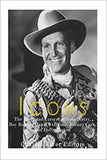Billie Holiday and Etta James: The Lives and Legacies of the Famous Jazz Singers
ISBN: 9781541055230
$7.99
*Includes pictures
*Includes the artists' quotes about their lives
*Includes online resources and a bibliography for further reading
*Includes a table of contents
If Billie Holiday wanted to become a jazz singer, she chose the best of all eras in which to attempt it. A wave of great jazz and jazz/pop crossover artists swept over the United States from the 1920s through the 1950s, generating a golden age for the genre. This wondrous jazz era was well represented by both black and white master artists, men, women, vocalists, and instrumentalists, and Billie Holiday has stood the test of time as well as any, despite struggling with an environment that easily could have doomed such aspirations.
Emerging from such a powerful group of talented vocalists was not easy. The woman who has come to represent a model of great, instinctive jazz singing came from nowhere, had nothing, and virtually had no one who was truly helpful in her background. She was raw and untrained but went forward regardless, with limited and quirky vocal gifts, the likes of which had never been heard in the highest circles of jazz. This especially was true among women, where perfection of phrasing and a smooth style of delivery stood as the unspoken guidelines of vocal success. No female counterpart of Louis Armstrong, one of Holiday’s idols, was ever going to survive in the female jazz world for long, except perhaps as a novelty.
It was not only hard-headed persistence that made Holiday “a preeminent female jazz vocalist” but a self-education, with the core belief that to sound like another singer was to not make music at all. Singing only from her deepest instinct and accepting no one as a literal model, she magically “changed the paradigm for jazz singing” by refusing to do anything the way it was expected to be done, or by swinging in any way that did not come authentically from her own artistry. Holiday “rewrote the rules” of jazz singing by using her voice not to imitate other singers, but by taking on the style of movement and sound common to jazz instruments. On top of that, she took the moderately employed practice of singing off the beat and brought it to the rhythmic forefront of virtually everything she sang. Holiday could “subtly twist [the] rhythm” in a way never before heard, “in the manner of an instrumental soloist.” Grateful to Louis Armstrong as a model, any song she took up was transformed rhythmically, tonally, and emotionally, with her “light and untrained” instrument, which despite its clarity could wield “a wounded poignancy” .
*Includes the artists' quotes about their lives
*Includes online resources and a bibliography for further reading
*Includes a table of contents
If Billie Holiday wanted to become a jazz singer, she chose the best of all eras in which to attempt it. A wave of great jazz and jazz/pop crossover artists swept over the United States from the 1920s through the 1950s, generating a golden age for the genre. This wondrous jazz era was well represented by both black and white master artists, men, women, vocalists, and instrumentalists, and Billie Holiday has stood the test of time as well as any, despite struggling with an environment that easily could have doomed such aspirations.
Emerging from such a powerful group of talented vocalists was not easy. The woman who has come to represent a model of great, instinctive jazz singing came from nowhere, had nothing, and virtually had no one who was truly helpful in her background. She was raw and untrained but went forward regardless, with limited and quirky vocal gifts, the likes of which had never been heard in the highest circles of jazz. This especially was true among women, where perfection of phrasing and a smooth style of delivery stood as the unspoken guidelines of vocal success. No female counterpart of Louis Armstrong, one of Holiday’s idols, was ever going to survive in the female jazz world for long, except perhaps as a novelty.
It was not only hard-headed persistence that made Holiday “a preeminent female jazz vocalist” but a self-education, with the core belief that to sound like another singer was to not make music at all. Singing only from her deepest instinct and accepting no one as a literal model, she magically “changed the paradigm for jazz singing” by refusing to do anything the way it was expected to be done, or by swinging in any way that did not come authentically from her own artistry. Holiday “rewrote the rules” of jazz singing by using her voice not to imitate other singers, but by taking on the style of movement and sound common to jazz instruments. On top of that, she took the moderately employed practice of singing off the beat and brought it to the rhythmic forefront of virtually everything she sang. Holiday could “subtly twist [the] rhythm” in a way never before heard, “in the manner of an instrumental soloist.” Grateful to Louis Armstrong as a model, any song she took up was transformed rhythmically, tonally, and emotionally, with her “light and untrained” instrument, which despite its clarity could wield “a wounded poignancy” .




